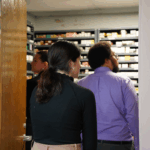Biography
Erin Hanson is an Assistant Professor in the Department of Chemistry and National Center for Forensic Science (Biological Evidence Section) at the University of Central Florida (UCF) and has a secondary joint appointment with the Violence Against Women faculty cluster (https://www.ucf.edu/research/violence-against-women/). She possesses a B.S. in Forensic Science, Biochemistry Track, a M.S. in Industrial Chemistry – Forensic Science Track, and a PhD in Biomedical Science from the University of Central Florida. She also has a graduate certificate in Forensic Genetic Genealogy from the University of New Haven. She currently teaches undergraduate Forensic Biochemistry courses (CHS3533, CHS3533L & CHS4534). Dr. Hanson’s research is in the area of forensic molecular genetics and includes a variety of research projects involving topics such as: 1) body fluid identification by RNA expression profiling, 2) improved recovery of male DNA in late reported and challenging sexual assault evidence, 3) rapid DNA analysis, 4) characterization and analysis of trace biological evidence (“touch DNA”), 5) single cell analysis and 6) forensic investigative genetic genealogy (FIGG).
Dr. Hanson is a member of the American Academy of Forensic Sciences (AAFS), the American Association for the Advancement of Science (AAAS), the International Society for Forensic Genetics (ISFG), the Association of Professional Genealogists (APG) and the FoRNAP Forensic RNA Profiling group. She is a co-organizer, with the Institute of Legal Medicine, Zurich, Switzerland, of the European DNA Profiling Group (EDNAP) sponsored collaborative exercises on the use of RNA expression profiling for body fluid identification. She is also a participant in the UCF WISE (Women in Science and Engineering) and is an active volunteer with the DNA Doe Project and the Victim Service Center of Central Florida.
When Dr. Hanson was an undergraduate forensic science student, a professor shared with the class a quote that has stuck with her since that time and has really become the foundation of her research group: “Wherever he steps, whatever he touches, whatever he leaves, even unconsciously, will serve as silent witness against him. Not even his fingerprints or his footprints, but his hair, the fibers from his clothes, the glass he breaks, the tool mark he leaves, the paint he scratches, the semen he deposits or collects – all of these bear mute witness against him. This is evidence that does not forget. It is not confused by the excitement of the moment. It is not absent because human witnesses are. It is factual evidence. Physical evidence cannot be wrong. It cannot perjure itself; it cannot be wholly absent; only its interpretation can err. Only human failure to find it, study and understand it, can diminish its values.” (Harris vs. United States, 331 U.S. 145 1947). The goal of her research group is to find it, study and understand it so that nothing diminishes the value of forensic evidence.


